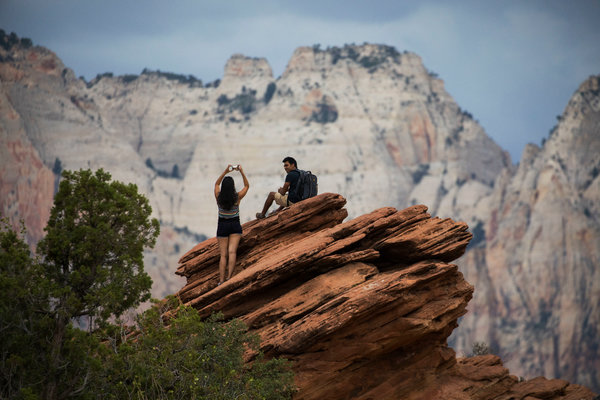For the last month, Marci T. House has had the perfect plan for the first week of the year: She would spend it in Washington’s museums and galleries, with her wife beside her. The first day was to be spent in the National Museum of African-American History and Culture; the second day at the National Portrait Gallery, taking photos in front of the Obamas’ portraits; the third day was for getting on tour buses and seeing outdoor monuments.
But that plan was ruined before it even began when Ms. House learned, after arriving in Washington on Tuesday, that the Smithsonian Institution’s museums, along with many other federally funded tourist attractions, were closing because of the government shutdown. The Smithsonian’s museums and the National Zoo initially remained open when the shutdown began on Dec. 22, but closed on Wednesday.
“We literally flew all day from Vancouver, British Columbia, to D.C. to see the museums and galleries,” said Ms. House, an actress. “Disappointed is putting it mildly.”
She and her wife now plan on spending their trip exploring the city’s monuments, like the National Mall, which is open, and are keeping their fingers crossed that the museums will open before the end of the week.
Here’s what travelers to Washington and other cities can expect during the shutdown.
Airports remain open
Transportation Security Administration employees are working without pay, but so far no major delays have been reported because of the shutdown.
How about National Parks?
The answer differs by state. Some states have stepped up to keep parks and monuments functioning: New York state is spending $65,000 a day to operate the Statue of Liberty and Ellis Island; Arizona is paying to keep the Grand Canyon open, Puerto Rico agreed to provide up to $80,000 for two weeks of services at the San Juan National Historic Site; Utah has kept visitors’ centers open at Arches, Bryce Canyon and Zion national parks.
At the Grand Canyon, the state of Arizona is paying for trash collection, custodial services for bathrooms and snow removal from sidewalks and trails. Stores and restaurants that aren’t run by the government are open. Campgrounds are open, but there is no reservation and check-in and check out process.
At Mount Rainier National Park in Washington state, the gate remained open, but officials cautioned that “entry during the federal shutdown is at visitors’ sole risk.”
In California, at Yosemite National Park, trash collection, along with visitors’ centers and the park’s restrooms have been closed since the shutdown began. Park officials closed two campgrounds and a redwood grove after finding human feces and urine on the park’s roads. Joshua Tree has been operating with some staff, but beginning Wednesday afternoon, is not allowing camping because of health concerns about near-capacity toilets.
Elizabeth Harris, a retired doctor who lives in San Rafael, Calif., arrived at Joshua Tree on Wednesday morning, and her son flew from Maryland to visit the park with his mother. “People plan their family vacations far ahead and our president doesn’t seem to care about that,” she said. “I’m so disappointed.” Campgrounds closed at noon, and Indian Cove and Black Rock campgrounds remained open for day-use only, sunrise to sunset.
The bright side for Ms. Harris: “We’re lucky to not be government employees, working and not getting paid.”
When it comes to National Parks, how closed is closed?
During the 2013 shutdown, the Obama administration ordered that the national park system completely close. The current administration opted to leave parks open, but unstaffed, frustrating park advocates and enthusiasts who believe the parks are unsafe without staff.
“We’re deeply concerned about the approach the administration has taken,” said John Garder, the senior budget director at the nonprofit National Parks Conservation Association. “Keeping the parks open is clearly causing threats to health and safety of visitors as well as wildlife and natural and cultural resources. We are worried about parks themselves, about park rangers who are demoralized, and the many businesses that depend on visitors.”

What about Smithsonian museums outside Washington?
There are three: the Air and Space Museum Udvar-Hazy Center in Chantilly, Va., and the Cooper-Hewitt National Design Museum and the American Indian Museum Heye Center in New York. They are also closed.
So what’s open in Washington?
In addition to any open-air monuments, any privately owned museum or attraction or one run by the District of Columbia is operating, which includes the Washington National Cathedral; the National Building Museum; Artechouse, a gallery that focuses on the intersection of art and technology; the Kreeger Museum, a museum at the former home of philanthropists David Lloyd Kreeger and Carmen Kreeger; and the Hillwood Estate, Museum and Garden, a decorative arts museum.
Park ranger-led tours and memorial shops are closed. And White House tours are suspended for the duration of the shutdown.
Follow NY Times Travel on Twitter, Instagram and Facebook. Get weekly updates from our Travel Dispatch newsletter, with tips on traveling smarter, destination coverage and photos from all over the world.






